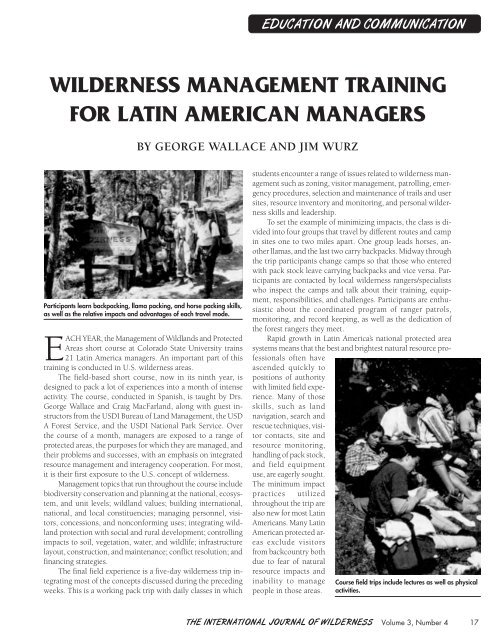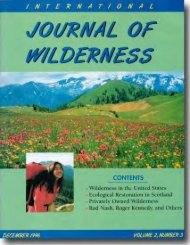Download full PDF - International Journal of Wilderness
Download full PDF - International Journal of Wilderness
Download full PDF - International Journal of Wilderness
You also want an ePaper? Increase the reach of your titles
YUMPU automatically turns print PDFs into web optimized ePapers that Google loves.
WILDERNESS MANAGEMENT TRAINING<br />
FOR LATIN AMERICAN MANAGERS<br />
BY GEORGE WALLACE AND JIM WURZ<br />
Participants learn backpacking, llama packing, and horse packing skills,<br />
as well as the relative impacts and advantages <strong>of</strong> each travel mode.<br />
EACH YEAR, the Management <strong>of</strong> Wildlands and Protected<br />
Areas short course at Colorado State University trains<br />
21 Latin America managers. An important part <strong>of</strong> this<br />
training is conducted in U.S. wilderness areas.<br />
The field-based short course, now in its ninth year, is<br />
designed to pack a lot <strong>of</strong> experiences into a month <strong>of</strong> intense<br />
activity. The course, conducted in Spanish, is taught by Drs.<br />
George Wallace and Craig MacFarland, along with guest instructors<br />
from the USDI Bureau <strong>of</strong> Land Management, the USD<br />
A Forest Service, and the USDI National Park Service. Over<br />
the course <strong>of</strong> a month, managers are exposed to a range <strong>of</strong><br />
protected areas, the purposes for which they are managed, and<br />
their problems and successes, with an emphasis on integrated<br />
resource management and interagency cooperation. For most,<br />
it is their first exposure to the U.S. concept <strong>of</strong> wilderness.<br />
Management topics that run throughout the course include<br />
biodiversity conservation and planning at the national, ecosystem,<br />
and unit levels; wildland values; building international,<br />
national, and local constituencies; managing personnel, visitors,<br />
concessions, and nonconforming uses; integrating wildland<br />
protection with social and rural development; controlling<br />
impacts to soil, vegetation, water, and wildlife; infrastructure<br />
layout, construction, and maintenance; conflict resolution; and<br />
financing strategies.<br />
The final field experience is a five-day wilderness trip integrating<br />
most <strong>of</strong> the concepts discussed during the preceding<br />
weeks. This is a working pack trip with daily classes in which<br />
EDUCATION AND COMMUNICATION<br />
students encounter a range <strong>of</strong> issues related to wilderness management<br />
such as zoning, visitor management, patrolling, emergency<br />
procedures, selection and maintenance <strong>of</strong> trails and user<br />
sites, resource inventory and monitoring, and personal wilderness<br />
skills and leadership.<br />
To set the example <strong>of</strong> minimizing impacts, the class is divided<br />
into four groups that travel by different routes and camp<br />
in sites one to two miles apart. One group leads horses, another<br />
llamas, and the last two carry backpacks. Midway through<br />
the trip participants change camps so that those who entered<br />
with pack stock leave carrying backpacks and vice versa. Participants<br />
are contacted by local wilderness rangers/specialists<br />
who inspect the camps and talk about their training, equipment,<br />
responsibilities, and challenges. Participants are enthusiastic<br />
about the coordinated program <strong>of</strong> ranger patrols,<br />
monitoring, and record keeping, as well as the dedication <strong>of</strong><br />
the forest rangers they meet.<br />
Rapid growth in Latin America’s national protected area<br />
systems means that the best and brightest natural resource pr<strong>of</strong>essionals<br />
<strong>of</strong>ten have<br />
ascended quickly to<br />
positions <strong>of</strong> authority<br />
with limited field experience.<br />
Many <strong>of</strong> those<br />
skills, such as land<br />
navigation, search and<br />
rescue techniques, visitor<br />
contacts, site and<br />
resource monitoring,<br />
handling <strong>of</strong> pack stock,<br />
and field equipment<br />
use, are eagerly sought.<br />
The minimum impact<br />
practices utilized<br />
throughout the trip are<br />
also new for most Latin<br />
Americans. Many Latin<br />
American protected areas<br />
exclude visitors<br />
from backcountry both<br />
due to fear <strong>of</strong> natural<br />
resource impacts and<br />
inability to manage<br />
people in those areas.<br />
Course field trips include lectures as well as physical<br />
activities.<br />
THE INTERNATIONAL JOURNAL OF WILDERNESS Volume 3, Number 4 17










